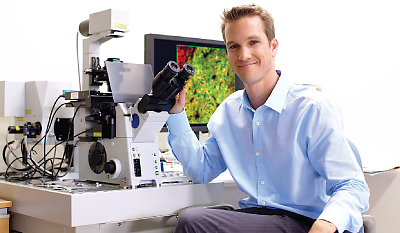Optogenetics. It’s being called the “hottest neuroscience technology developed in the past seven years,” and the June 15 Biological Psychiatry highlights the myriad ways in which it is being used—and the tremendous potential it holds.
Optogenetics is the combination of genetic and optical methods to control specific events in targeted cells of living tissue, even within freely moving mammals and other animals, with the temporal precision (millisecond-timescale) needed to keep pace with their functioning, intact biological systems. And it’s a technology that’s generating a lot of excitement.
“It has been said that scientific progress depends more on new technologies than new concepts. In truth, it is often new technologies that generate new concepts,” wrote Thomas Insel, M.D., director of the National Institute of Mental Health (NIMH), and Michelle Freund, Ph.D., chief of NIMH’s Molecular Biotechnology Program, in their commentary introducing the series of articles.
Joshua Johansen, Ph.D., of the RIKEN Brain Science Institute Laboratory for Neural Circuitry of Memory in Saitama, Japan, and his colleagues, are enthusiastic about the directions in which the technology is leading their studies of the neural circuits of fear: “Until recently, technological limitations have made it difficult to study the causal role of specific circuit elements during fear conditioning,” they wrote. “[O]ptogenetic tools allow researchers to manipulate individual circuit components such as anatomically or molecularly defined cell populations, with high temporal precision.”
Mary Kay Lobo, Ph.D., an assistant professor of anatomy and neurobiology with a secondary appointment in psychiatry at the University of Maryland School of Medicine, and her colleagues described their work using optogenetic tools to answer a broad range of molecular, cellular, and circuit-level questions pertaining to depression that, so far, have been resistant to other experimental approaches: “Recent advances in optogenetics permit control over specific subtypes of neurons or their afferent or efferent projections and can greatly further our understanding of the neural mechanisms involved in depression and the mechanism of action of deeper brain stimulation and perhaps chemical antidepressants,” they explained.
Luis de Lecea, Ph.D., an associate professor in the Department of Psychiatry and Behavioral Science at Stanford University School of Medicine, and his colleagues are using optogenetics to elucidate the neurobiological mechanisms controlling the boundaries between arousal, hyperarousal, and hypoarousal: “Optogenetic tools now provide a better alternative for controlling neural circuits in vivo to examine sleep/wake boundaries. In future research, it will be important to determine the mechanisms by which each arousal system affects hypoarousal and hyperarousal based on anatomical projection, synaptic neurotransmission, and the frequency patterns of stimulation. Such experiments will undoubtedly shine light on how neural circuits share such functions in the normal and the pathological brain.”
Ofer Yizhar, Ph.D., a senior scientist in the Department of Neurobiology at the Weizmann Institute of Science in Rehovot, Israel, whose work focuses on the basic mechanisms of prefrontal function and on disease-related changes and their electrophysiological and behavioral correlates, imagines the near-future possibilities of optogenetic technology: “Study of social behaviors under more naturalistic settings will necessitate the development of novel methods for delivering light to the brain with minimal constraints on animal handling and movement. Techniques for wireless light delivery and telemetric electrophysiological recordings will greatly enhance the scope of possible experiments and allow the examination of sensitive social interactions with minimal intervention.”
Insel and Freund shared the excitement of these researchers, describing optogenetics as an enticing gateway to a new frontier: “There remain entire areas of perception, emotion, and cognition to be explored,” they wrote, and the series of reports in
Biological Psychiatry “offers an exciting harvest of some of the first fruits of this technology.”


